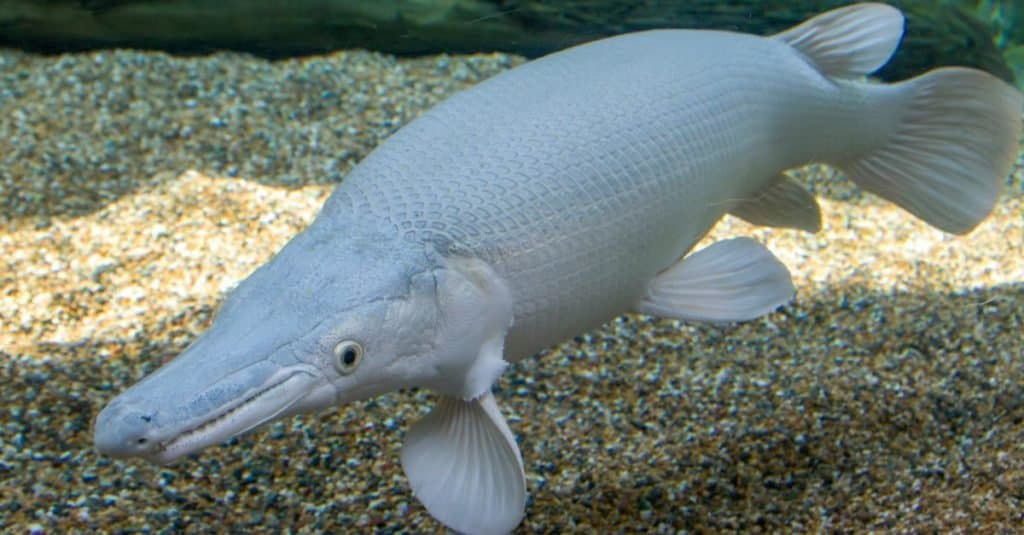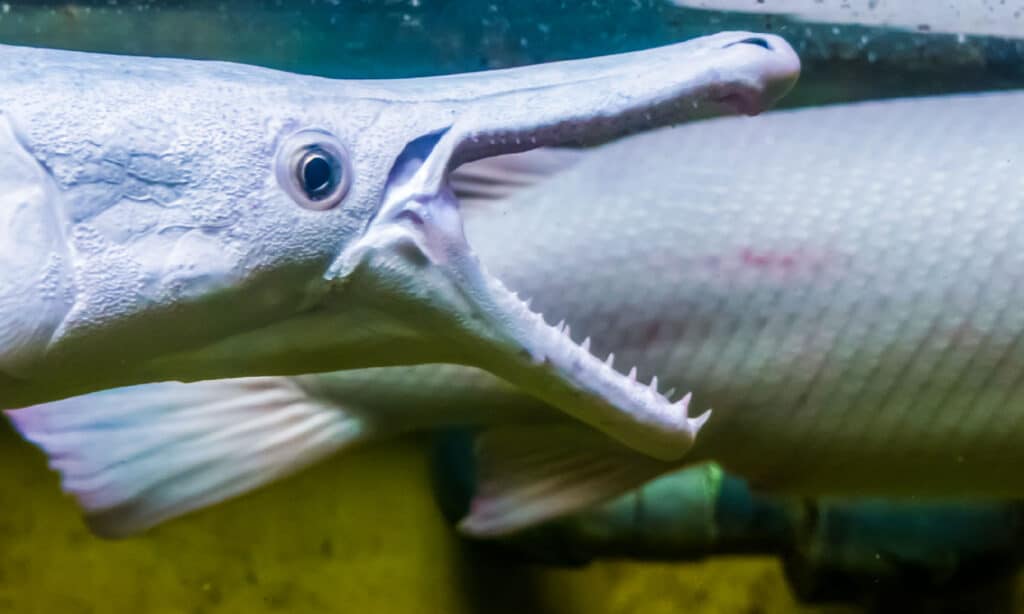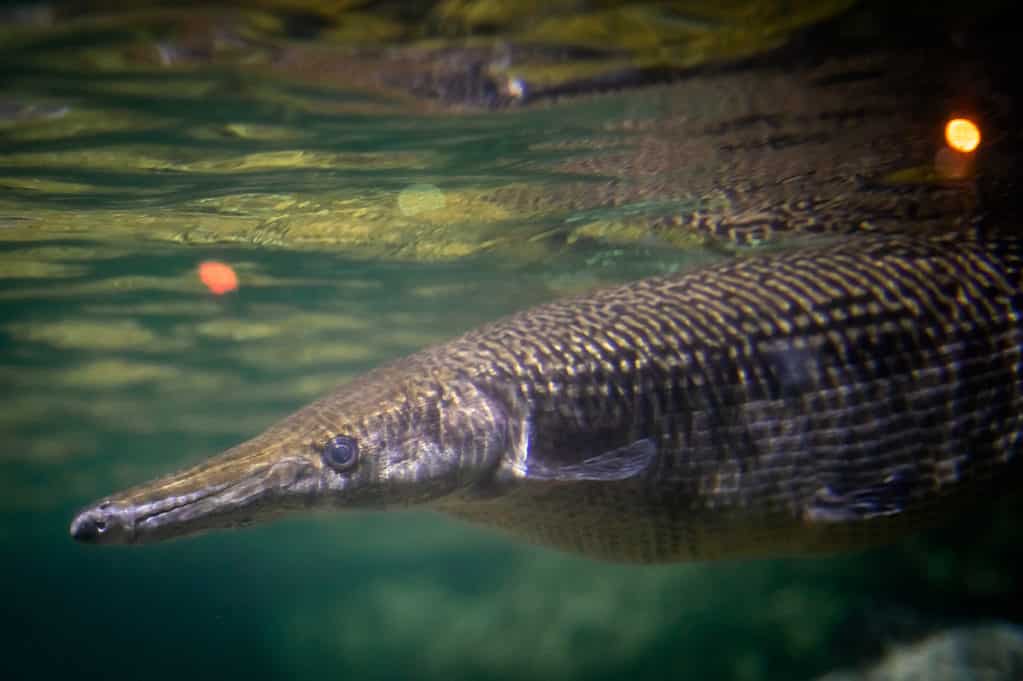Gar
Lepisosteidae
The gar evolved from an ancient lineage of fish!
Advertisement
Gar Scientific Classification
- Kingdom
- Animalia
- Phylum
- Chordata
- Class
- Actinopterygii
- Order
- Lepisosteiformes
- Family
- Lepisosteidae
- Scientific Name
- Lepisosteidae
Read our Complete Guide to Classification of Animals.
Gar Conservation Status
Gar Facts
- Prey
- Crustaceans, insects, frogs, and fish
- Group Behavior
- Solitary/Group
- Fun Fact
- The gar evolved from an ancient lineage of fish!
- Estimated Population Size
- The gar evolved from an ancient lineage of fish!
- Biggest Threat
- Hunting
- Most Distinctive Feature
- The long snout
- Other Name(s)
- Garpike
- Gestation Period
- A few days
- Optimum pH Level
- 6 - 9
- Habitat
- Rivers, bayous, lakes, and estuaries
- Predators
- Large Fish, Alligators, Humans
- Diet
- Carnivore
- Favorite Food
- Fish
- Type
- Fish
- Common Name
- Gar
- Average Clutch Size
- 10
- Slogan
- Can grow to more than 3m long!

Resembling a cross between a reptile and a fish, the garfish is a family of long-nosed carnivorous animals that inhabit the freshwaters of North America.
They make slow, languid movements through the water, but this merely hides how quickly they can strike at their prey.
Although numbers are dwindling in some areas, the garfish is not yet threatened by human activity. In Europe and Australia, gar refers to a different unrelated family of needlefish, which sometimes causes confusion.
3 Incredible Gar Facts!

Throughout history, people have utilized the tough scales of the gar to create various items, including jewelry, lampshades, plows, arrows, and armor.
©Danny Ye/Shutterstock.com
- The garfish arose some 157 million years ago in the late Jurassic Period. Based on fossil evidence, it originally evolved in Mexico and then radiated out to Europe and the rest of America when the two continents were still closely aligned. This ancient lineage is evident in the gar’s cartilage-based skeletal system and reptile-like vertebrae.
- The hard scales of the gar have been used to make jewelry, lampshades, plows, arrows, and armor throughout history.
- Because of its unusual body structure, the gar is a popular fish at several aquariums, including the Georgia Aquarium, the Tennessee Aquarium, and the National Aquarium in Baltimore.
Scientific Name

The term “gar” can refer to either the order of Lepisosteiformes or the family of Lepisosteidae within this order.
©Charlotte Bleijenberg/Shutterstock.com
Gar, as a taxonomical term, can describe either the order of Lepisosteiformes or the specific family of Lepisosteidae within this order. Both terms derive from the Latin word lepis for scales. All types of gar belong to the class of ray-finned fish known as the Actinopterygii.
Evolution and Origins
Gars are recognized as the sole surviving representatives of the Ginglymodi, a category of bony fish that thrived during the Mesozoic period. The earliest known ginglymodians emerged in the Middle Triassic, which is more than 240 million years in the past.
Fossils show that fish species such as the Alligator gar have been in existence for over 100 million years, dating back to the Early Cretaceous period.
Belonging to the Lepisosteidae family, gars are freshwater fish that are generally sizable. There are seven known species of gar, which include the alligator, Cuban, Florida, longnose, shortnose, spotted, and tropical varieties.
Gars are exclusively found in North America, Central America, and Cuba, ranging from southeastern Canada to Panama, but are not present in regions west of the Rocky Mountains.
The longnose gar (Lepisosteus osseus) has the most extensive distribution among the species. While primarily inhabiting freshwater environments, gars may occasionally explore saltwater or brackish water regions.
The 7 Different Species

The Cuban gar or manjuari is found in rivers and lakes of western Cuba. Cuban gar eggs are poisonous for humans.
©iStock.com/Siraj Ahmad
There are seven living species of garfish (five of them in Florida alone) and several more extinct species known from the fossil record. The first three species belong to the genus of Atractosteus, whereas the final four belong to the species of Lepisosteus.
- Alligator Gar: As the largest species of gar, this species is sometimes mistaken for the alligator. It inhabits the Southeast United States and Mexico.
- Cuban Gar: This freshwater fish inhabits the rivers and lakes of western Cuba.
- Tropical Gar: As one of the few exclusively tropical gar, this species inhabits a range of territory between southern Mexico and Costa Rica, where it feeds primarily on cichlids and other tropical fish.
- Florida Gar: Found exclusively in Florida and Georgia, this species prefers the muddy bottoms of rivers and lakes.
- Spotted Gar: With its small, black spotted body, this fish inhabits the waters of Lake Michigan, Lake Eerie, and the Mississippi River System down to the Gulf of Mexico.
- Shortnose Gar: This aptly named species is endemic to the Mississippi River and surrounding bodies of water.
- Longnose Gar: With its long, narrow snout, the longnose gar inhabits a large range of territory across most of the Eastern United States.
Appearance
The most interesting physical characteristic of this fish is perhaps the most obvious. With its narrow body, protruding snout, and feather-like tail, it looks a bit like a dart. This is actually an important adaptation. The massive snout contains rows and rows of sharp needle-like teeth that help with crushing shells and consuming prey.
Another important adaptation is the way that the swim bladder is connected directly to the esophagus. This allows the gar to breathe in the air amid stagnant low-oxygen water.
The largest species in the family is the alligator gar, which measures around 10 feet in length and weighs up to 350 pounds. This species also ranks among the largest of all freshwater fish in the world. The smallest species is the shortnose gar at around 2 feet in length.
The female tends to be larger than the male in the spotted gar and a few other species. Most of them have interlocking and protective bony plates known as ganoid scales sometimes arranged in a diamond shape all over their bodies.

The majority of these fish inhabit freshwater rivers, bayous, and other brackish water environments that have low levels of oxygen, although a few species can also be found in saltwater bodies.
©Raimond Spekking / CC-BY-SA-3.0 (via Wikimedia Commons) / GFDL
Distribution, Population, and Habitat
These fish are largely confined to freshwater rivers, bayous, and other brackish water with low oxygen content, but a few species venture out into saltwater bodies as well. The fish floats slowly like logs in the water, sometimes plumbing the depths in search of food, but it must return to the surface occasionally to take in air.
Although exact population numbers are unknown, the gar as a whole is in good health. According to conservation estimates, almost every species is listed as least concern, which is the best possible prognosis, but some local populations appear to be decreasing in number. For instance, the alligator gar is becoming rarer in states like Missouri and Tennessee.
Predators and Prey
The fish’s diet consists mainly of crustaceans, insects, frogs, and other fish. These slow-moving animals are opportunistic predators that scoop up nearby prey in its mouth with a simple strike of the head. It is not particularly picky about whether the prey is dead or alive.
Because of their status as apex predators throughout their natural habitat, they have few natural predators besides humans. The biggest threat to this animal is not necessarily fishing, as they are uncommonly eaten as food, but hunting and pollution have caused some population numbers to decline.
Reproduction and Lifespan
No matter where they live, most species (with the exception of the longnose gar) prefer to spawn in the spring. The females move to the shallow water and then deposit on vegetation thousands of large-sized sticky eggs with yolk contained within. These eggs are actually toxic to many predators, including humans, which affords a degree of protection (though some fish appear to be immune to the toxin).
After a few days, the young larvae emerge from the eggs and then attach to the vegetation with an adhesive organ at the tip of the snout. The young juveniles survive the early stages of life by absorbing what remains of the egg yolk and later by feeding on minnows and other fish larvae.
Life expectancy varies by species, but the fish reaches sexual maturity after a few years and lives about 10 to 20 years in the wild (though the alligator gar appears to live 50 years or more). In many species, the female tends to live longer than the male.
Fishing and Cooking
This is not a very common type of dish, especially outside of its native region, but it is sometimes caught by both commercial and recreational fishers with simple nets or fishing rods. People describe it as having a firm, mild taste, different from any other species of fish.
Their flesh is not harmful on its own, but it does sometimes accumulate toxins and pollution from the environment and so consumption is limited or banned in some areas. By contrast, the eggs are most certainly toxic and may cause a bout of sickness.
View all 170 animals that start with GGar FAQs (Frequently Asked Questions)
What does gar eat?
The gar’s diet consists of crustaceans, insects, frogs, and other fish.
Are gars aggressive?
The gar may have a rather fearsome appearance with its scaly skin and sharp teeth, but it actually has no interest in anything outside of its traditional prey, and it has never been known to attack humans. People who catch gar may want to watch out for its teeth when it thrashes around though.
Is gar good to eat?
The gar has a mild and nutritious flesh that is suitable for frying, but in no circumstances should you eat the toxic eggs. If you are cooking gar by yourself, then you should cut out the eggs and surrounding flesh.
Does gar scare away bass?
Gar may have the tendency to scare away smaller game fish, but there is a misconception that the gar is a “trash fish” that destroys nets and decimates fish populations. This led to a mass culling of alligator gar in the 20th century. As the gar’s reputation improved (and misconceptions were corrected), so did the population numbers.
What is the biggest gar ever caught?
The largest gar ever recorded was 8.5 feet long and weighed 327 pounds. Having lived to a ripe old age of 94, this alligator gar was accidentally discovered at Lake Chotard in Mississippi in 2011.
What Kingdom do Gars belong to?
Gars belong to the Kingdom Animalia.
What phylum to Gars belong to?
Gars belong to the phylum Chordata.
What family do Gars belong to?
Gars belong to the family Lepisosteidae.
What order do Gars belong to?
Gars belong to the order Lepisosteiformes.
What type of covering do Gars have?
Gars are covered in Scales.
In what type of habitat do Gars live?
Gars live in rivers, bayous, lakes, and estuaries.
What are some predators of Gars?
Predators of Gars include large fish, alligators, and humans.
How many eggs do Gars lay?
Gars typically lay 10 eggs.
What is an interesting fact about Gars?
Gars can grow to more than 3m long!
What is the scientific name for the Gar?
The scientific name for the Gar is Lepisosteidae.
What is a distinguishing feature of the Gar?
Gars have a long snout.
What is the lifespan of a Gar?
Gars can live for 10 to 20 years.
What is the biggest threat to the Gar?
The biggest threat to the Gar is hunting.
What is the optimal pH for a Gar?
The optimal pH for a Gar is between 6.0 and 9.0.
What is another name for the Gar?
The Gar is also called the garpike.
How do Gars have babies?
Gars lay eggs.
Thank you for reading! Have some feedback for us? Contact the AZ Animals editorial team.
Sources
- David Burnie, Dorling Kindersley (2011) Animal, The Definitive Visual Guide To The World's Wildlife
- Tom Jackson, Lorenz Books (2007) The World Encyclopedia Of Animals
- David Burnie, Kingfisher (2011) The Kingfisher Animal Encyclopedia
- Richard Mackay, University of California Press (2009) The Atlas Of Endangered Species
- David Burnie, Dorling Kindersley (2008) Illustrated Encyclopedia Of Animals
- Dorling Kindersley (2006) Dorling Kindersley Encyclopedia Of Animals
- Britannica, Available here: https://www.britannica.com/animal/gar
- Seaworld Parks & Entertainment, Available here: https://seaworld.org/animals/facts/bony-fish/gars/
- Florida Fish and Wildlife Conservation Commission, Available here: https://myfwc.com/research/freshwater/sport-fishes/alligator-gar/profile/
- Texas Parks & Wildlife, Available here: https://tpwd.texas.gov/fishboat/fish/management/alligator-gar/edible.phtml

















